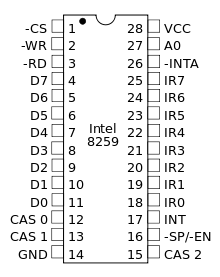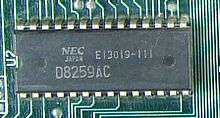Intel 8259
The Intel 8259 is a Programmable Interrupt Controller (PIC) designed for the Intel 8085 and Intel 8086 microprocessors. The initial part was 8259, a later A suffix version was upward compatible and usable with the 8086 or 8088 processor. The 8259 combines multiple interrupt input sources into a single interrupt output to the host microprocessor, extending the interrupt levels available in a system beyond the one or two levels found on the processor chip. The 8259A was the interrupt controller for the ISA bus in the original IBM PC and IBM PC AT.

The 8259 was introduced as part of Intel's MCS 85 family in 1976. The 8259A was included in the original PC introduced in 1981 and maintained by the PC/XT when introduced in 1983. A second 8259A was added with the introduction of the PC/AT. The 8259 has coexisted with the Intel APIC Architecture since its introduction in Symmetric Multi-Processor PCs. Modern PCs have begun to phase out the 8259A in favor of the Intel APIC Architecture. However, while not anymore a separate chip, the 8259A interface is still provided by the Platform Controller Hub or Southbridge chipset on modern x86 motherboards.
Functional description
The main signal pins on an 8259 are as follows: eight interrupt input request lines named IRQ0 through IRQ7, an interrupt request output line named INTR, interrupt acknowledgment line named INTA, D0 through D7 for communicating the interrupt level or vector offset. Other connections include CAS0 through CAS2 for cascading between 8259s.
Up to eight slave 8259s may be cascaded to a master 8259 to provide up to 64 IRQs. 8259s are cascaded by connecting the INT line of one slave 8259 to the IRQ line of one master 8259.
There are three registers, an Interrupt Mask Register (IMR), an Interrupt Request Register (IRR), and an In-Service Register (ISR). The IRR maintains a mask of the current interrupts that are pending acknowledgement, the ISR maintains a mask of the interrupts that are pending an EOI, and the IMR maintains a mask of interrupts that should not be sent an acknowledgement.
End Of Interrupt (EOI) operations support specific EOI, non-specific EOI, and auto-EOI. A specific EOI specifies the IRQ level it is acknowledging in the ISR. A non-specific EOI resets the IRQ level in the ISR. Auto-EOI resets the IRQ level in the ISR immediately after the interrupt is acknowledged.
Edge and level interrupt trigger modes are supported by the 8259A. Fixed priority and rotating priority modes are supported.
The 8259 may be configured to work with an 8080/8085 or an 8086/8088. On the 8086/8088, the interrupt controller will provide an interrupt number on the data bus when an interrupt occurs. The interrupt cycle of the 8080/8085 will issue three bytes on the data bus (corresponding to a CALL instruction in the 8080/8085 instruction set).
The 8259A provides additional functionality compared to the 8259 (in particular buffered mode and level-triggered mode) and is upward compatible with it.
Programming considerations
DOS and Windows

Programming an 8259 in conjunction with DOS and Microsoft Windows has introduced a number of confusing issues for the sake of backwards compatibility, which extends as far back as the original PC introduced in 1981.
The first issue is more or less the root of the second issue. DOS device drivers are expected to send a non-specific EOI to the 8259s when they finish servicing their device. This prevents the use of any of the 8259's other EOI modes in DOS, and excludes the differentiation between device interrupts rerouted from the master 8259 to the slave 8259.
The second issue deals with the use of IRQ2 and IRQ9 from the introduction of a slave 8259 in the PC/AT. The slave 8259's INT output is connected to the master's IR2. The IRQ2 line of the ISA bus, originally connected to this IR2, was rerouted to IR1 of the slave. Thus the old IRQ2 line now generates IRQ9 in the CPU. To allow backwards compatibility with DOS device drivers that still set up for IRQ2, a handler is installed by the BIOS for IRQ9 that redirects interrupts to the original IRQ2 handler.
On the PC, the BIOS (and thus also DOS) traditionally maps the master 8259 interrupt requests (IRQ0-IRQ7) to interrupt vector offset 8 (INT08-INT0F) and the slave 8259 (in PC/AT and later) interrupt requests (IRQ8-IRQ15) to interrupt vector offset 112 (INT70-INT77). This was done despite the first 32 (INT00-INT1F) interrupt vectors being reserved by the processor for internal exceptions (this was ignored for the design of the PC for some reason). Because of the reserved vectors for exceptions most other operating systems map (at least the master) 8259 IRQs (if used on a platform) to another interrupt vector base offset.
Other operating systems
Since most other operating systems allow for changes in device driver expectations, other 8259 modes of operation, such as Auto-EOI, may be used. This is especially important for modern x86 hardware in which a significant amount of time may be spent on I/O address space delay when communicating with the 8259s. This also allows a number of other optimizations in synchronization, such as critical sections, in a multiprocessor x86 system with 8259s.
Edge and level triggered modes
Since the ISA bus does not support level triggered interrupts, level triggered mode may not be used for interrupts connected to ISA devices. This means that on PC/XT, PC/AT, and compatible systems the 8259 must be programmed for edge triggered mode. On MCA systems, devices use level triggered interrupts and the interrupt controller is hardwired to always work in level triggered mode. On newer EISA, PCI, and later systems the Edge/Level Control Registers (ELCRs) control the mode per IRQ line, effectively making the mode of the 8259 irrelevant for such systems with ISA buses. The ELCR is programmed by the BIOS at system startup for correct operation.
The ELCRs are located 0x4d0 and 0x4d1 in the x86 I/O address space. They are 8-bits wide, each bit corresponding to an IRQ from the 8259s. When a bit is set, the IRQ is in level triggered mode; otherwise, the IRQ is in edge triggered mode.
Spurious interrupts
The 8259 generates spurious interrupts in response to a number of conditions.
The first is an IRQ line being deasserted before it is acknowledged. This may occur due to noise on the IRQ lines. In edge triggered mode, the noise must maintain the line in the low state for 100 ns. When the noise diminishes, a pull-up resistor returns the IRQ line to high, thus generating a false interrupt. In level triggered mode, the noise may cause a high signal level on the systems INTR line. If the system sends an acknowledgment request, the 8259 has nothing to resolve and thus sends an IRQ7 in response. This first case will generate spurious IRQ7's.
A similar case can occur when the 8259 unmask and the IRQ input de-assertion are not properly synchronized. In many systems, the IRQ input is deasserted by an I/O write, and the processor doesn't wait until the write reaches the I/O device. If the processor continues and unmasks the 8259 IRQ before the IRQ input is deasserted, the 8259 will assert INTR again. By the time the processor recognizes this INTR and issues an acknowledgment to read the IRQ from the 8259, the IRQ input may be deasserted, and the 8259 returns a spurious IRQ7.
The second is the master 8259's IRQ2 is active high when the slave 8259's IRQ lines are inactive on the falling edge of an interrupt acknowledgment. This second case will generate spurious IRQ15's, but is rare.
PC/XT and PC/AT
The PC/XT ISA system had one 8259 controller, while PC/AT and later systems had two 8259 controllers, master and slave. IRQ0 through IRQ7 are the master 8259's interrupt lines, while IRQ8 through IRQ15 are the slave 8259's interrupt lines. The labels on the pins on an 8259 are IR0 through IR7. IRQ0 through IRQ15 are the names of the ISA bus's lines to which the 8259s are attached.
Variants
| Model Number | Temperature Range | Date of Release | Price (USD)[list 1] |
|---|---|---|---|
| ID8259 | Industrial | March/April 1979[1] | $23.15 |
| M8259 | Military | March/April 1979[2] | $95.00 |
- In quantities of 100 and up
See also
- Advanced Programmable Interrupt Controller (APIC)
- IF (x86 flag)
- Intel APIC Architecture
- Interrupt handler
- Interrupt latency
- Non-maskable interrupt (NMI)
- Programmable Interrupt Controller (PIC)
References
- Intel Corporation, "Microcomputer Component: New industrial grade product line answers the demand for high-reliability components to operate in industrial applications.", Intel Preview, March/April 1979, Pg. 11
- Intel Corporation, "Military Products: Intel marches on!", Intel Preview, March/April 1979, Pg. 19
- Gilluwe, Frank van. The Undocumented PC. A-W Developers Press, 1997. ISBN 0-201-47950-8
- McGivern, Joseph. Interrupt-Driven PC System Design. Annabooks, 1998. ISBN 0-929392-50-7
- IBM Personal System/2 Hardware Interface Technical Reference - Architectures. IBM, 1990. IBM Publication 84F8933